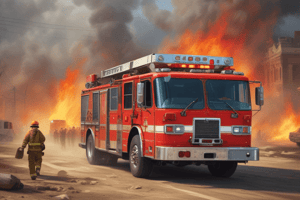Podcast
Questions and Answers
What is the primary goal of fire prevention strategies?
What is the primary goal of fire prevention strategies?
- To increase the number of natural fires.
- To maximize fuel buildup in forests.
- To reduce the likelihood of unwanted fires starting. (correct)
- To allow all naturally ignited fires to burn freely.
What does the Incident Command System (ICS) provide for incident management?
What does the Incident Command System (ICS) provide for incident management?
- An unstructured communication method.
- A standardized, on-scene, all-hazard management concept. (correct)
- A chaotic response to incidents.
- A flexible approach with limited structure.
What is a key purpose of prescribed fires?
What is a key purpose of prescribed fires?
- To increase hazardous fuel buildup.
- To reduce hazardous fuel buildup. (correct)
- To ignore weather and fuel conditions.
- To eliminate wildlife habitats.
In fire ecology, what positive effect can fire have on biodiversity?
In fire ecology, what positive effect can fire have on biodiversity?
What is the purpose of smoke management plans?
What is the purpose of smoke management plans?
What is a major impact of climate change on wildfires?
What is a major impact of climate change on wildfires?
What is a mitigation strategy used in the wildland-urban interface?
What is a mitigation strategy used in the wildland-urban interface?
How does GIS mapping help in fire management?
How does GIS mapping help in fire management?
Why is collaboration important in fire management?
Why is collaboration important in fire management?
What is the purpose of post-fire rehabilitation efforts?
What is the purpose of post-fire rehabilitation efforts?
Flashcards
Fire Management
Fire Management
Strategies for preventing, suppressing, and utilizing fire to meet ecological, economic, and social goals.
Fire Prevention
Fire Prevention
Reduces the likelihood of unwanted fires starting through education, regulations, and fuel management.
Fire Suppression
Fire Suppression
Involves controlling and extinguishing wildfires using ground crews, air support, and incident management teams.
Incident Command System (ICS)
Incident Command System (ICS)
Signup and view all the flashcards
Wildland Fire Use
Wildland Fire Use
Signup and view all the flashcards
Prescribed Fire
Prescribed Fire
Signup and view all the flashcards
Fire Ecology
Fire Ecology
Signup and view all the flashcards
Smoke Management
Smoke Management
Signup and view all the flashcards
Mitigation Strategies
Mitigation Strategies
Signup and view all the flashcards
Fire Management Plans
Fire Management Plans
Signup and view all the flashcards
Study Notes
- Fire management encompasses a range of strategies aimed at preventing, suppressing, and utilizing fire to meet ecological, economic, and social goals
Wildland Fire Management
- Wildland fire management specifically addresses fires in forests, grasslands, and other natural areas
Objectives
- Protecting human life, property, and resources
- Maintaining or restoring ecosystem health
- Supporting sustainable economies near wildlands
Fire Prevention
- Fire prevention aims to reduce the likelihood of unwanted fires starting
- Public education programs increase awareness about fire safety
- Enforcing regulations on open burning and fireworks
- Maintaining fuel breaks involves removing vegetation to reduce fire spread
- Prescribed burns reduce built up fuel in an area
Fire Suppression
- Fire suppression involves controlling and extinguishing wildfires
- Initial attack involves quickly responding to and suppressing new fires
- Ground crews use hand tools, vehicles, and water to fight fires
- Air support uses aircraft for water and retardant drops, reconnaissance, and transportation
- Incident management teams coordinate large or complex fire incidents
Incident Command System (ICS)
- ICS is a standardized, on-scene, all-hazard incident management concept
- ICS allows for coordination and collaboration among various agencies and responders
- ICS provides a clear chain of command and communication protocols
Wildland Fire Use
- Wildland fire use allows naturally ignited fires to burn under specific conditions
- Goals include restoring fire-adapted ecosystems and reducing fuel accumulation
- Requires a fire management plan with clearly defined parameters
- Monitored closely to ensure fires stay within prescribed boundaries
Prescribed Fire
- Prescribed fire, or controlled burning, involves intentionally igniting fires
- Reduces hazardous fuel buildup
- Improves wildlife habitat
- Controls competing vegetation
- Prepares sites for planting or seeding
- Conducted under specific weather and fuel conditions
Fire Ecology
- Fire ecology studies the effects of fire on ecosystems
- Many ecosystems are fire-adapted and depend on periodic fire
- Fire can promote biodiversity by creating habitat diversity
- Fire can stimulate seed germination and nutrient cycling
Effects on Vegetation
- Fire can kill some plants while stimulating growth in others
- Some plants have adaptations to survive or thrive after fire
- Seed dispersal and seedling establishment can be enhanced by fire
Effects on Wildlife
- Fire can create new habitat for some species
- Fire can reduce habitat for other species
- Fire intensity and frequency affect wildlife populations
Smoke Management
- Smoke from wildland and prescribed fires can impact air quality
- Smoke management plans aim to minimize smoke impacts on communities
- Techniques include timing burns to coincide with favorable weather conditions
- Using ignition techniques to reduce smoke production
- Notifying the public about planned burns
Air Quality Regulations
- Air quality regulations limit the amount of pollutants that can be emitted
- Fire managers must comply with these regulations
- Monitoring air quality during and after fires is important
Climate Change Implications
- Climate change is increasing the frequency and intensity of wildfires
- Warmer temperatures, drier conditions, and longer fire seasons contribute
- Changes in vegetation patterns can also increase fire risk
- Fire management strategies must adapt to these changing conditions
Challenges
- Increasing wildland-urban interface creates challenges for fire suppression
- Limited resources can hinder fire management efforts
- Communication and coordination among agencies can be complex
- Public perception of fire can be negative
Mitigation Strategies
- Creating defensible space around homes
- Using fire-resistant building materials
- Developing community wildfire protection plans
- Promoting fire-wise landscaping
Technology in Fire Management
- Remote sensing technologies such as satellites and drones monitor fire activity
- GIS mapping helps to plan and manage fires
- Predictive models forecast fire behavior
- Communication systems allow for real-time information sharing
Data Analysis
- Analyzing fire data helps to improve fire management strategies
- Data includes fire occurrence, size, location, and cause
- Data is used to assess risk and prioritize resources
Collaboration
- Fire management requires collaboration among various stakeholders
- Federal, state, and local agencies work together
- Private landowners and community groups are also involved
- Collaboration is essential for effective fire management
Community Involvement
- Engaging communities in fire management is crucial
- Educating residents about fire risk and prevention measures
- Encouraging participation in fire-wise programs
- Building trust between fire managers and the public
Economic Aspects
- Fire management has significant economic implications
- Suppression costs can be very high
- Damage to property and resources can be substantial
- Prescribed fire can be a cost-effective management tool
Forest Management Practices
- Thinning forests reduces fuel loads and decreases fire risk
- Salvage logging removes dead trees after a fire
- Reforestation restores forests after a fire
- These practices can influence fire behavior and ecosystem recovery
Invasive Species
- Invasive species can alter fire regimes
- Some invasive plants increase fire frequency and intensity
- Fire can promote the spread of invasive species
- Managing invasive species is important for fire management
Post-Fire Rehabilitation
- Rehabilitation efforts aim to restore ecosystems after a fire
- Seeding and planting can stabilize soils and promote vegetation recovery
- Erosion control measures prevent sediment from entering waterways
- Monitoring helps to assess the effectiveness of rehabilitation efforts
Importance of Planning
- Fire management plans outline strategies for preventing, suppressing, and using fire
- Plans consider ecological, economic, and social factors
- Plans are regularly updated to reflect changing conditions
- Planning is essential for effective fire management
Research and Development
- Ongoing research improves understanding of fire behavior and effects
- New technologies and techniques are developed to enhance fire management
- Research helps to inform policy and practice
- Continued investment in research is crucial
Studying That Suits You
Use AI to generate personalized quizzes and flashcards to suit your learning preferences.





